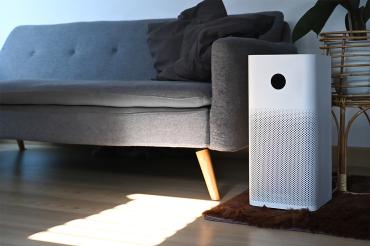Second-hand cannabis smoke: Researchers investigate involuntary THC exposure in homes

An air purifier can help mitigate the impact of second-hand cannabis smoke in homes, with researchers noting that THC's chemical structure makes it prone to sticking on surfaces (photo by iStock)
Published: April 6, 2023
University of Toronto researchers are investigating exposure to second-hand – and even third-hand – marijuana smoke in homes, including the THC that can collect on floors and surfaces.
The researchers, in Faculty of Applied Science & Engineering, have published a new study that models how THC – the main psychoactive ingredient in cannabis – behaves and transforms once it is released in an indoor environment.
The model enables researchers to explore mitigation strategies that could reduce involuntary exposure levels.
“We began our research on tetrahydrocannabinol (THC), which is the psychoactive part of cannabis that causes intoxication, because when we looked at second- and third-hand smoke, we started to see how much involuntary exposure happens,” says Amirashkan Askari, a PhD candidate in department of chemical engineering and applied chemistry.
Askari co-authored the study with U of T Engineering Associate Professor Arthur Chan and Frank Wania, a professor in the department of physical and environmental sciences at U of T Scarborough.
Between April 2021 and March 2022, Canadians spent $4 billion on regulated, adult-use cannabis, according to Statistics Canada. Dried cannabis accounted for 71.1 per cent of sales, indicating that smoking is the most popular method of consumption.
“Any type of smoking, whether it is tobacco or cannabis, leaves behind a suite of pollutants that can remain in homes,” says Chan. “We now have sufficient chemical knowledge about THC to model its behavior in a typical indoor environment.”
Moreover, involuntary THC exposure can continue long after smoking has ceased. This is due to THC’s large and complex chemical structure, which has a strong tendency to stick to surfaces and create third-hand exposure,” says Askari.
“There are a lot of surfaces indoors – tables, chairs and floors. When you calculate the ratio of surfaces to volume, it is quite elevated compared to the outdoors,” he says. “So, when a pollutant is emitted, it always has the chance to migrate from air to surfaces.
“Involuntary exposure to pollutants starts to become more important when we consider infants and children who reside in homes where this smoking takes place. Children tend to touch surfaces more than adults as they crawl or play; they are also known to frequently put their hands or objects in their mouth.”
Askari used a time-dependent indoor mass-balance model to forecast the level of human exposure to THC. The study also examined the effectiveness of mitigating strategies – from air purifiers to surface cleaners – in reducing second- and third-hand exposure from marijuana smoke.
The model was run for one simulated year under the assumption that THC from single-stream smoke (the lighted end) of a burning cannabis cigarette was emitted into the indoor air for one hour daily.
By modelling the exposure level of an adult and a toddler (who were distinguished by body weight) Askari predicted that residents of all ages who are present during smoking sessions are vulnerable to high levels of involuntary second-hand THC.
The exposure analysis also found that carpet and flooring materials were significant reservoirs of THC that migrated from air to surface. Since younger children are prone to object mouthing – a common part of infant and toddler development – this makes them especially sensitive to THC from third-hand exposure. These results, the study concludes, highlight the importance of preventing children from accessing spaces where cannabis smoking takes place, both during and after smoking.
“When it comes to improving indoor air quality, the best way to degrade air pollutants is to shut down the source,” says Askari.
“But if our aim is to suppress it, we found the most effective measures were strategies that target the air particles directly. So, if you have an air purifier unit that filters particulate matter from the air, that will reduce that exposure significantly.”
While the researchers’ initial study used computer simulation, the second phase of this cannabis and indoor air pollution research involves experiments in collaboration with the Centre for Addiction and Mental Health (CAMH).
“We had volunteers come in and either smoke or vape cannabis,” says Askari. “We measured the composition of air in real time – while they were consuming the cannabis – so we could see what happens to the air quality. We also did comparisons between smoking and vaping.”
The results from this second study have not been published, but the team hopes this research will help individuals and policymakers better understand how this source of indoor air pollution impacts the health of communities.
“We hope that people will start paying more attention to indoor air quality, not just during these high-emitting activities, but also long after they are over,” Chan says.
“Keeping our homes well-ventilated is very effective at lowering our exposures, even if it is just for a brief period of time during and after smoking.”



